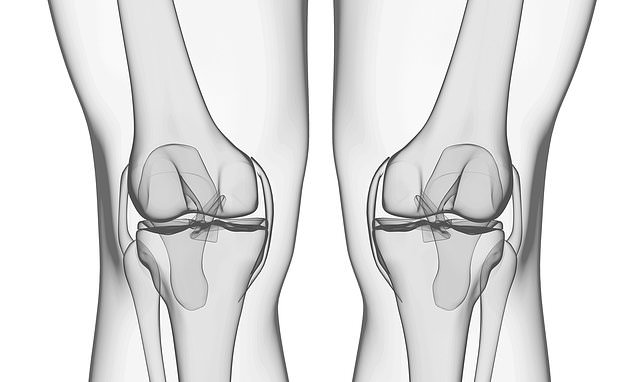No more knee replacements? Implant that zaps the inside of the knee joint to stimulate the growth of cartilage could be a new way to tackle osteoarthritis
An implant that zaps the inside of the knee joint to stimulate the growth of cartilage could be a new way to tackle osteoarthritis and reduce the need for knee replacement.
Scientists at the University of Connecticut in the U.S. have developed a patch that generates tiny amounts of electricity to trigger the growth of cartilage, the tissue that acts as a cushion to stop bones from rubbing against each other and causing pain.
These tiny electrical pulses, released by the implant when the knee joint moves, stimulate nearby cartilage cells to start growing until they form a ‘patch’ of new cushion.
Around 8.5 million people in the UK have painful joints due to osteoarthritis, or ‘wear-and-tear’ arthritis — and osteoarthritis of the knee, the strongest joint in the body, is estimated to affect one in five adults aged over 45.

Scientists at the University of Connecticut in the U.S. have developed a patch that generates tiny amounts of electricity to trigger the growth of cartilage, the tissue that acts as a cushion to stop bones from rubbing against each other and causing pain
Articular cartilage, a smooth, slippery substance, coats the ends of the bones where they meet in the joint and acts as a cushion. But it becomes frayed over time, resulting in bone rubbing on bone, pain and loss of movement.
Treatment ranges from painkillers to ease the discomfort, to physiotherapy and knee braces that support and strengthen the muscles around the joint.
An estimated 60,000 people undergo a knee replacement in the UK every year because, unlike other tissues in the body, articular cartilage cannot regrow or heal because it lacks the necessary blood vessels.
Now researchers at the University of Connecticut have found that low levels of electricity can help trigger the growth of new cartilage cells.
They have developed a small scaffold which looks like a patch and can be matched to the size of the defect and surgically implanted. It is made from a biodegradable material, Poly-L-Lactic acid (or PLLA), a type of plastic. This has a property, called piezo‑electricity, which means it produces a tiny burst of electricity when squeezed — the movement of a joint, such as walking, causes the PLLA scaffold to generate a weak but steady electrical field. This encourages cells to colonise it and grow into cartilage. The implant itself then eventually biodegrades.
Animal studies by the researchers showed that after one to two months, robust cartilage grew back inside the joints. By contrast, there was little or no healing of the damaged cartilage in a control group that received a standard tissue scaffold, reports the journal Science Translational Medicine. Clinical trials in humans are planned soon.
Mike McNicholas, a consultant orthopaedic surgeon at Liverpool University Hospitals, said: ‘Piezoelectricity has been found to be incredibly widespread in body tissues, and is present in some of the body’s building block molecules, such as collagen.
‘Electrical stimulation is recognised as a way of helping broken bones heal quicker and has been in clinical use for decades.
‘This study’s results are very impressive. It will be interesting to see if they are reproducible in man. The development of this novel therapeutic implant to restore cartilage volume and fill in defects could be a game-changer in the battle against arthritis.’
A capsule containing curcumin (the yellow compound found in turmeric) may help treat knee arthritis, according to the results of a new trial published in the journal Nutrients.
In the study, patients took either a 500mg curcumin capsule or a placebo twice a day for eight weeks. The curcumin group were able to reduce their pain-relieving medication on average by 37 per cent compared to 13 per cent for the patients taking a placebo. Curcumin is thought to work as an anti-inflammatory.
How yoghurt can make berries even healthier
Eating blueberries with yoghurt may improve your intake of the nutrients they provide, suggests the Journal of Agricultural and Food Chemistry.
In research with rats, alpha-casein (a milk-based protein) was added to anthocyanin (an antioxidant that gives blueberries their colour) — the next day the rodents had higher concentrations of anthocyanin in their blood.
The researchers said the milk protein molecule ‘wraps around’ the antioxidant, stopping it disintegrating as it moves through the intestine and bloodstream.
They will now see if the protein has the same effect in the human digestive system.
Ten minutes of exercise is enough to boost mood, say researchers at Tsukuba University in Japan. They asked 26 adults to perform mental tasks before and after running on a treadmill for ten minutes.
After the run, tasks took less time and the participants’ mood improved, possibly as physical activity affects the pre-frontal cortex, the brain area involved in emotion, said the researchers.
Weight gain after you stop smoking linked to bacteria
The balance of bacteria in the gut may explain weight gain in those who quit smoking.
Scientists from the Icahn School of Medicine in the U.S. found that antibiotics can prevent weight gain in mice which have been adapted to suddenly gain weight in the same way as smokers who’ve quit, suggesting that certain strains of bacteria contribute to the problem.
The animals’ weight remained stable for weeks after the medication, the journal Nature reports. Previously, weight gain after smoking was thought to be due to comfort eating.
Clock watching
How to harness the power of your body clock. This week: Eat supper by 6pm

Having your supper in the early evening could have benefits ranging from reduced heartburn to a lower risk of cancer.
A study in the American Journal of Gastroenterology in 2005 found that people who eat dinner within three hours of going to bed are seven times more likely to experience heartburn than those who wait four hours before turning in.
Heartburn is often worse when you lie down because the acid can flow back up the oesophagus; the extra hour gives the food, which stimulates production of the acid, time to leave the stomach.
Meanwhile, a 2018 study in the International Journal of Cancer found that people who ate at least two hours before bed were 20 per cent less likely to develop breast or prostate cancer. It’s thought eating earlier is more in tune with our body clock.
Rude health
Men with gum disease may be at twice the risk of prostate problems, such as prostatitis, according to a study based on more than 5,000 men. The researchers, from the Tri‑Service General Hospital in Taiwan, suggest bacteria involved in gum disease may cause inflammation in other parts of the body.
Jargon buster
Scientific terms decoded. This week: Endocrine system
The endocrine system is made up of glands responsible for the production and release of hormones — needed for metabolism, growth, stress and sexual function.
These glands include the ovaries, testes, pancreas, and adrenal glands, which release hormones directly into the bloodstream.
The endocrine system is monitored by the pituitary gland — found at the front of the brain near the nose — which, in turn, reports to the hypothalamus, an area of the brain responsible for temperature control, hunger and sleep, and which can help adjust hormone secretion according to the body’s needs.
Ageing, medications and diseases can lead to the over or under secretion of hormones. And now some scientists have noted that Covid can lead to hormone-related disorders, possibly because the virus attacks the pituitary gland.
Measuring brain stem responses could help to diagnose tinnitus
A new diagnostic tool for tinnitus might finally be on the horizon following study results published in the Journal of Clinical Investigation.
The condition typically causes a ringing or buzzing noise in the ear without any obvious source, but there is no test to confirm diagnosis.
Now researchers at Karolinska Institute in Sweden have discovered that measuring auditory brainstem responses (ABR) — which examine the brain’s response to sound stimuli — can distinguish patients with tinnitus from those without.
It’s thought that alterations in brain activity, as a result of initial noise exposure damaging hearing cells in the ear, could be a sign of the condition and that ABR measurements may reflect this.
Measuring blood levels of antioxidants, compounds that protect cells from damage, could reveal the risk of Alzheimer’s disease.
A study by researchers at the Institut National de la Recherche Scientifique in Canada found that signs of cell damage — caused by molecules called free radicals — start to rise in the five years before the onset of Alzheimer’s.
This affects blood vessels in the brain, limiting blood flow in the area, which is a risk factor for the disease.
The study identified the link with antioxidant levels in a common form of Alzheimer’s that typically affects those with a gene called APOE4.
The researchers suggest that boosting antioxidants — for example, through supplements — may cut the risk of the disease.
Source: Read Full Article
